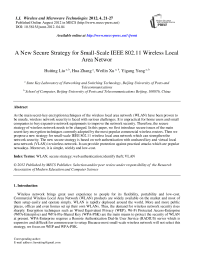A New Secure Strategy for Small-Scale IEEE 802.11 Wireless Local Area Network
Автор: Huiting Liu, Hua Zhang, Weilin Xu, Yigang Yang
Журнал: International Journal of Wireless and Microwave Technologies(IJWMT) @ijwmt
Статья в выпуске: 4 Vol.2, 2012 года.
Бесплатный доступ
As the main secret-key encryption techniques of the wireless local area network (WLAN) have been proven to be unsafe, wireless network security is faced with serious challenges. It is unpractical for home users and small companies to buy expansive network equipments to improve the network security. Therefore, the secure strategy of wireless network needs to be changed. In this paper, we first introduce secure issues of the main secret-key encryption techniques currently adopted by the most popular commercial wireless routers. Then we propose a new strategy for small-scale IEEE 802.11 wireless local area network which can strengthen the network security. The new secure strategy is based on web authentication with unshared key and virtual local area network (VLAN) in wireless network. It can provide protection against practical attacks which are popular nowadays. Moreover, it is simple, wieldy and low-cost.
WLAN, secure strategy, web authentication, identify theft, VLAN
Короткий адрес: https://sciup.org/15012817
IDR: 15012817
Список литературы A New Secure Strategy for Small-Scale IEEE 802.11 Wireless Local Area Network
- E. Tews, R.-P. Weinmann, and A. Pyshki, “Breaking 104—bit WEP in less than 60 seconds,” WISA'07 Proceedings, Springer-Verlag Berlin, Heidelberg, pp. 188-202, 2007.
- E. Tews, M. Beck, “Practical attacks against WEP and WPA,” WiSec '09 Proceedings, ACM New York, pp.79-86. 2009
- M. Beck, “Enhanced TKIP michael attacks”, unpublished.
- Xiaoyun Wang, Dengguo Feng, Xuejia Lai, and Hongbo Yu, “Collisions for hash functions MD4, MD5, HAVAL-128 and RIPEMD,” Crypto 2004, August, 2004, retrieved July 27, 2008, in press.
- Xiaoyun Wang and Hongbo Yu, “How to break MD5 and other hash functions,” EUROCRYPT 2005 Proceedings, Springer-Verlag Berlin, Heidelberg, pp.19-35, 2005. Retrieved December 21, 2009.
- J. Black, M. Cochran, and T. Highland, “A study of the MD5 attacks: insights and improvements,” FSE 2006 Proceedings, Springer-Verlag Berlin, Heidelberg, pp.262-277, March, 2006. Retrieved July 27, 2008.
- M. Stevens, A. Lenstra, and B. Weger, “Chosen-Prefix collisions for MD5 and colliding X.509 certificates for different identities”, EUROCRYPT '07 Proceedings, Springer-Verlag Berlin, Heidelberg, pp.1-22, 2007.


